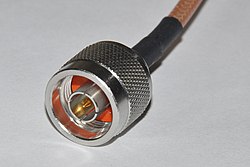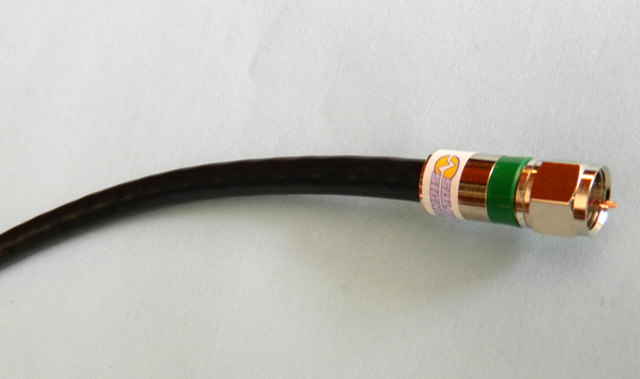When you think about it, a cable isn’t just the wire. The ends are important too. They’re the point of contact between the wire and everything else, and if that connection isn’t very good, then you’ll have problems.
Coaxial cables use a variety of connectors but they all have one thing in common: the center conductor of the wire forms part of the connector. Take a look at this RCA connector, used for audio and video connections:

The wire on the inside is soldered (you hope) to the center part of the connection. This introduces some loss and potentially some interference. With audio, and even with standard-definition video, there isn’t really much to worry about because the signal isn’t as complex as it is for cable, satellite, and HDTV.
Now, take a look at this coaxial cable:

As you can see the center conductor is part of the connector. It will make direct contact with the device it’s connected to. Loss is kept at a minimum and the signal is as strong as it can be.
Types of coaxial connectors
The F connector, shown in the picture above, is the most common for cable, satellite and HDTV uses. It uses a hexagonal, screw-on outer shell that can be tightened with a 7/16″ or 11mm wrench. It can also be configured as a push-on connector, and we’ll discuss the benefits of that a little later in the article.

The BNC connector, shown above, is most commonly used for commercial video applications. Unlike the screw-on F connector, it uses a “push and turn” motion that makes it easy to connect and disconnect firmly without a wrench. However, its construction allows signal “leakage” in the higher frequencies. This isn’t an issue for HD video or computer data transmitted locally on relatively low frequencies but it makes the BNC connector a worse choice for cable or satellite.

This is the N connector. It’s not seen as commonly but it’s a really beefy connector for long runs. It uses a screw-on outer connector to minimize signal leakage as well as a center shield to further isolate the cable. This connector has been in wide use for a long time and it’s more common in older installations done before compression connectors became common.
What to look for in a connector

This image, courtesy of Wikipedia, shows one of the worst possible F connector installs.
Let’s take a look at this picture and see what’s wrong with it. First, start with the yellow color of the connector. Gold colored connectors became popular in the 1980s when high-end audio fans used real gold-plated ones to make better connections. Unfortunately this opened the door for other people to slap gold paint on their connectors because it’s hard to tell the difference.
This connector is either painted or it’s solid brass. Either way, that’s not so great. Painting a connector actually reduces the quality of the signal, and brass connectors are great when you buy them but oxidize quickly, leading to signal loss.
The knurled edge of this connector means it’s probably a screw-on type. Screw-on connectors are a cheap way for DIY’ers to build cables without tools. Unfortunately they often end up loose and the screw-on action can tear the inner braid or destroy a thin foil shield. Just stay away from screw-on connectors.
Look at the dielectric. A good cable should have the dielectric flush with the inner edge of the connector, while this dielectric is sunk down.
As if this poor cable hadn’t suffered enough, look at the center conductor! It should be straight and free of kinks, with a sharp, 90 degree cut at the edge. This conductor isn’t going to make good contact, because it’s all kinked.
Molded, crimped, or compression?
Molded connections are made of plastic which is then melted together for a weatherproof seal. There’s nothing really wrong with this except that molded connections don’t usually have the level of shielding they should, and they are almost always attached to poor-performing cables.
Hex crimped cables were the norm until about ten years ago. A hex crimped connector can perform very well and professionals out in the field can make hex crimped connectors that work great. A crimping tool presses on the lower part of the connector (which starts out round) until it presses firmly into the jacket of the cable. However, because a lot of techs use wrenches instead of proper tools or just don’t take good care in making cables, most cable and satellite companies don’t recommend hex crimped cables.
Compression connectors are the standard for all cable, satellite, and antenna connections today. A special tool is used to prepare the cable to exact tolerances: .25″ (6.35mm) long center conductor, followed by .25″ of dielectric showing, and .25″ of shield showing. The technician loads the prepared cable and a loose connector into the tool where lever action compresses all the parts together for a tight seal. Making a good connector is almost automatic.
Push-on or screw-on?
Push-on connectors aren’t really a bad thing. Some techies will tell you that since a push-on connector only makes contact with the outer surface of the screw threads, there isn’t enough of a connection. That’s really not true. The big dangers from push-on cables are signal leakage and poor fit over time. The push-on connector is usually in two or more parts and signal can leak out in the gap between them. Also, the push-on connector relies on friction and nothing else, and over time it can become loose as metals expand and contract.
Some high-end installations, such as those for apartment buildings, rely on commercial equipment with push-on connectors, but they are properly shielded and the equipment is “locked in” so it can’t move.
For home wiring, rely on screw-on connectors for everything, except possibly the final connection to the TV where you can reach the connection if it gets loose.
In our next article, we’ll talk about signal loss, how it’s measured and why it happens.





